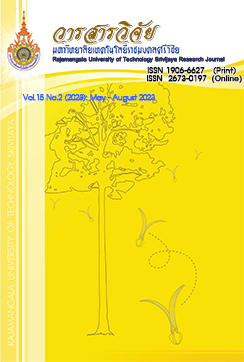Classification of Chinese Herb Images Using Deep Learning Technique via Android Application
Keywords:
classification, Chinese herb image, deep learning, convolutional neural network, applicationAbstract
Currently, the herb-based health-care has been receiving more attention, especially Chinese herbs that are able to alleviate or treat diseases. However, examining the type and remedial effect of Chinese herbs remains difficult for the general public. This research aimed to develop an android application for classification of Chinese herb images with deep learning technique. The research started from preparation of 2,640 test images for processing. The next step was taking the collected images to be used as a training set for training the model, based on deep learning, convolutional neural network by using Tensorflow’s library for image classification. This model was trained to be able to recognize 12 Chinese herbs. Then, the model was developed into an application. The last step was application performance testing. The statistics used in this research were the accuracy, precision, recall, mean, and standard deviation. The research found that (1) the deep learning model for Chinese herb classification at 500 cycles had the maximum accuracy of 98.30%, precision of 98.29% and recall of 98.30%; 2) the results showed that average accuracy of the application for Chinese herb image classification was 89.17%; and (3) performance assessment by experts had high suitability, and the results of the user satisfaction of the application was at a high level with an average of 4.23. The experimental results indicate that the developed application can effectively help classify Chinese herb image.
References
Atole, R. and Park, D. 2018. A Multiclass Deep Convolutional Neural Network Classifier for Detection of Common Rice Plant Anomalies. International Journal of Advanced Computer Science and Applications 9(1): 67-70.
Boonkidram, S. and Sriwiboon, N. 2020. Physical Quality Investigation of Germinated Brown Rice by using Image Processing. Journal of Information Science and Technology 10(2): 101-109. (in Thai)
Butploy, N. and Boonying, S. 2020. Classification of Benjapakee Buddha amulets image by deep learning. RMUTSB Academic Journal 8(1): 100-111. (in Thai)
Carrio, A., Sampedro, C., Rodriguez-Ramos, A. and Campoy, P. 2017. A Review of Deep Learning Methods and Applications for Unmanned Aerial Vehicles. Journal of Sensors 2017(1): 1-13.
Gaticaa, G., Bestb, S., Ceronic, J. and Lefranc, G. 2013. Olive fruits recognition using neural networks. Procedia Computer Science 2013(17): 412-419.
Health Book Editor. 2013. The miracle of Chinese herbs for treat disease and health care. 1sted. Se-education, Bangkok. (in Thai)
Huachiew Traditional Chinese Medicine Clinic. 2021. What is Traditional Chinese medicine?. Huachiew Traditional Chinese Medicine. Available Source: https://www.huachiewtcm.com, September 9, 2021. (in Thai)
Jmour, N., Zayen, S. and Abdelkrim, A. 2018. Convolutional neural networks for image classification, pp. 397-402. In Proceedings of the 2018 International Conference on Advanced Systems and Electrical Technologies. ASET Association, Hammamet.
Lim, G. and Chuah, J. 2018. Durian types recognition using deep learning techniques, pp. 183-187. In Proceedings of IEEE Control and System Graduate Research Colloquium. University Technology Mara, Shah Alam.
Lu, Y., Yi, S., Zeng, N., Liu, Y. and Zhang, Y. 2017. Identification of rice diseases using deep convolutional neural networks. Neurocomputing 2017(267): 378-384.
Manoi, N., Bunjanda, A. and Rattanapoka, C. 2019. A System for Cooking Recipe Sharing and Cooking Recipe Finding by an Image of Ingredients using Deep Learning Technique. The Journal of Industrial Technology 15(2): 97-111. (in Thai)
Muneer, A. and Fati, S. 2020. Efficient and Automated Herbs Classification Approach Based on Shape and Texture Features using Deep Learning. IEEE Access 8(1): 196747-196764.
Petagon, R. and Pantho, O. 2020. Drone for Detecting Forest Fires using Deep Learning Technique. The Sripatum Review of Science and Technology 12(1): 65-78. (in Thai)
Sanuksan, J. and Surinta, O. 2019. Deep Convolutional Neural Networks for Plant Recognition in the Natural Environment. Journal of Science and Technology Mahasarakham University 38(2): 113-124. (in Thai)
Sladojevic, S., Arsenovic, M., Anderla, A., Culibrk, D. and Stefanovic, D. 2016. Deep Neural Networks Based Recognition of Plant Diseases by Leaf Image Classification. Computational Intelligence and Neuroscience 2016(1): 1-11.
Verma, A., Singh, P. and Alex, J. 2019. Modified Convolution Neural Network Architecture Analysis for Facial Emotion Recognition, pp. 169-173. In Proceedings of the 2019 International Conference on Systems, Signals and Image Processing. University of Osijek, Osijek.
Wannawibul, P. 2012. Know choose know use 100 Chinese herbs. 1st ed. Thongkasem Publishing, Bangkok. (in Thai)
Downloads
Published
How to Cite
Issue
Section
License
Copyright (c) 2023 Rajamangala University of Technology Srivijaya Research Journal

This work is licensed under a Creative Commons Attribution-NonCommercial-NoDerivatives 4.0 International License.
The content and information in the article published in Journal of Rajamangala University of Technology Srivijaya It is the opinion and responsibility of the author of the article. The editorial journals do not need to agree. Or share any responsibility.







